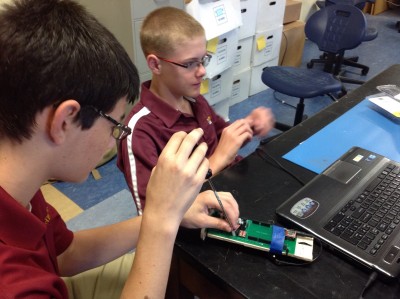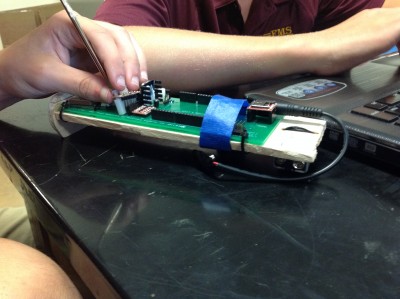STEM in Action: Fishburne TARC Team Sets Lofty Goals

Cadets Saltzman (Leonardtown, MD) and Mercer (Lyndhurst, VA) work together at West Virginia University during summer TARC camp.
Waynesboro, VA–Fishburne’s Team America Rocketry Challenge (TARC) team started off with a bang (or perhaps a whoosh) this September. Cadets Samuel Saltzman (Leonardtown, MD), Torian Irons (Alexandria, VA), and Alex Sponeman (Fishers, IN) have worked together to create the first rocket for the TARC 2016 contest. Saltzman was one of the team members who participated in a NASA-sponsored TARC camp this summer at West Virginia University. The three will be joined this year by Cadets James Brown (Stafford, VA) and Diran Chertavian (Hawi, HI).
This will be the third consecutive year that Fishburne is involved with TARC, which is the world’s largest student rocket contest. The event draws around 4,000 students every year to compete in all aspects of rocket design. Rules and parameters change every year in order to challenge students in different ways. This year’s contest asks students to design, build, and fly their own rockets.
The Fishburne team has been heavily engaged in the engineering cycle, from building and testing through a computer aided design (CAD) and launch simulation, to the actual building of their design to be tested in October. So far, the results have been encouraging .
.
“This is the closest any team I have sponsored in the past has designed a rocket that acts perfectly in the simulation program we use,” said Fishburne math instructor and Rocketry Club adviser CPT Tom Galloway. “If their designed rocket performs this consistently in the actual launch, they will likely go to the national tournament in 2016.”
The team is now finishing their first build and plans on adding two or three more rockets to match their CAD simulation. They are learning how very slight changes in any one physical feature can have a large effect on the balance and telemetry needed for a successful flight. In addition, conditions on launch day are often hard to duplicate or simulate exactly. “Accounting for environmental variables is one of the most difficult things” when moving from simulation to physical design, noted Cadet Saltzman.
The next step is to finish the rocket and test it October 10th. The test launch will take place at the Valley Aerospace Team (VAST) launch site in Monterey, Virginia. The TARC team is eagerly waiting to see if their physical rocket design meets performance predictions, or if adjustments need to be made in order to improve their final design.
Fishburne’s TARC team is part of the school’s STEM Initiative, which offers cadets exciting ways to learn and use science, technology, engineering and math.
To learn more about Team America Rocketry Challenge, go to http://rocketcontest.org/.
Fishburne Military School is the oldest and smallest of all military schools for boys in Virginia. Its college-prep curriculum is built upon the structure of an Army JROTC program. Boasting a 100% college placement rate for the past 10 consecutive years, FMS has also been designated as a JROTC Honor Unit with Distinction and may nominate qualified candidates to the United States Service Academics. Fishburne hosts one of only four Summer JROTC programs in the nation, accredited by US Army Cadet Command.



